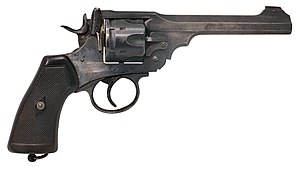| Webley Revolver | |
|---|---|
 A Webley Mk. VI top-break revolver. | |
| Type | Service revolver |
| Place of origin | United Kingdom |
| Service history | |
| In service | 1887–1963[1] |
| Used by | See Users |
| Wars | Second Boer War Boxer Rebellion World War I Easter Rising Irish War of Independence Irish Civil War World War II Northern Campaign Indonesian National Revolution Malayan Emergency First Indochina War Korean War Vietnam War British colonial conflicts Border Campaign The Troubles |
| Production history | |
| Designer | Webley & Scott |
| Designed | 1887 |
| Manufacturer | Webley & Scott, RSAF Enfield |
| Produced | 1887–1924 |
| No. built | approx. 125,000 |
| Specifications (Revolver Mk VI) | |
| Mass | 2.4 lb (1.1 kg), unloaded |
| Length | 11.25 in (286 mm) |
| Barrel length | 6 in (150 mm) |
| Cartridge | |
| Calibre | .455 (11.6 mm) |
| Action | Single or double action |
| Rate of fire | 20–30 rounds/minute |
| Muzzle velocity | 620 ft/s (190 m/s) |
| Effective firing range | 50 yd (46 m) |
| Feed system | 6-round cylinder |
| Sights | Fixed front blade and rear notch |
The Webley Revolver (also known as the Webley Top-Break Revolver or Webley Self-Extracting Revolver) was, in various designations, a standard issue service revolver for the armed forces of the United Kingdom, and countries of the British Empire and the Commonwealth of Nations, from 1887 to 1963.
The Webley is a top-break revolver and breaking the revolver operates the extractor, which removes cartridges from the cylinder. The Webley Mk I service revolver was adopted in 1887 and the Mk IV rose to prominence during the Boer War of 1899–1902. The Mk VI was introduced in 1915, during wartime, and is the best-known model.
Firing large .455 Webley cartridges, Webley service revolvers are among the most powerful top-break revolvers produced. The .455 calibre Webley is no longer in military service. As of 1999[update], the .38/200 Webley Mk IV variant was still in use as a police sidearm in a number of countries.[2]
- ^ Dabbs, W. (2022, January 17). The webley revolver: Sidearm of an Empire. The Armory Life. https://www.thearmorylife.com/the-webley-revolver-sidearm-of-an-empire/
- ^ "Historic firearm of the month", July 1999, Cruffler.com. Retrieved on 2006-12-02